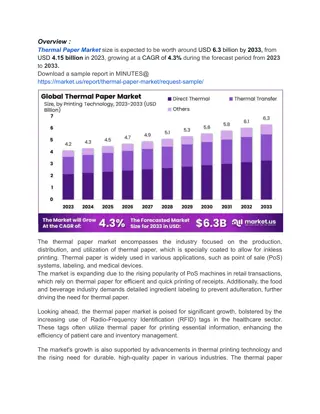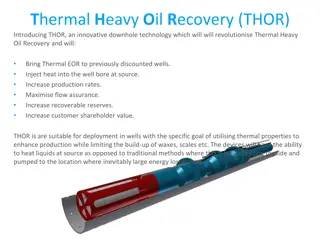Therminator: Thermal Simulator for Smartphones
Therminator is a thermal simulator designed to address the thermal challenges faced by smartphones due to their high power density and compact size. It produces accurate chip and skin temperature maps, aiding in optimizing thermal management strategies. The tool assists in designing the most appropriate location, size, and material composition of thermal pads, ensuring optimal thermal performance and user experience for mobile devices.
Download Presentation

Please find below an Image/Link to download the presentation.
The content on the website is provided AS IS for your information and personal use only. It may not be sold, licensed, or shared on other websites without obtaining consent from the author.If you encounter any issues during the download, it is possible that the publisher has removed the file from their server.
You are allowed to download the files provided on this website for personal or commercial use, subject to the condition that they are used lawfully. All files are the property of their respective owners.
The content on the website is provided AS IS for your information and personal use only. It may not be sold, licensed, or shared on other websites without obtaining consent from the author.
E N D
Presentation Transcript
Therminator: A Thermal Simulator for Smartphones Producing Accurate Chip and Skin Temperature Maps Qing Xie, Mohammad Javad Dousti, and Massoud Pedram University of Southern California ISLPED 2014, 08/11/2014 International Symposium on Low Power Electronics and Design
Outline Motivation Thermal challenge for smartphones Design time thermal simulator Therminator Overview Compact thermal modeling Temperature results validation Parallel computing feature Case study on Samsung Galaxy S4 Impact of skin temperature setpoint Impact of thermal characteristics of materials Conclusion 2 ISLPED 2014
Motivation Smartphones are getting hot Not only the popularity, but also the temperature Higher power density Smaller physical size Components are close to each other No active cooling mechanism Thermal challenges Conventional thermal constraint Maximum junction temperature (Tj) Application processor is the major heat generator in the mobile device Typical critical temperature as high as 85 ~ 100 C High die temperature High leakage, fast aging, etc. A new thermal constraint ! Breakdown of Samsung Galaxy S3 3 ISLPED 2014
Thermal Challenge Smartphones Thermal challenge, cont d A new thermal constraint Maximum skin temperature Skin temperature the hotspot temperature on the surface of mobile devices Typical critical temperature 45 C High skin temperature Bad user experience, or even burn users Apple iPad3 hits 46.7 C !! by consumer reports Modern smartphone manufacturers put a lot of efforts on improving the thermal design Determine the most appropriate location, size, material composition of thermal pads Thermal images of Asus Transformer TF300 4 ISLPED 2014
Design Time Thermal Simulator A good thermal simulator at the design time Generate temperature maps for different components in mobile devices Application processor, front screen, rear case, battery, etc. Optimize the thermal path design Material composition, 3D layout, etc. Optimize the thermal management policy Control setpoint, control step-size, etc. Computational Fluid Dynamics (CFD) tool Expensive license Slow for large input size Develop a compact and integratable tool Compact thermal modeling Easy to integrate with other performance simulators 5 ISLPED 2014
Overview of Therminator Therminator a thermal simulator for smartphones Inputs: Design_specification.xml 3D layout Material composition Power.trace Power consumption of major components Output: Temperature maps Temperature distribution for each component 6 ISLPED 2014
Compact Thermal Modeling Compact thermal modeling Based on duality between the thermal and electrical phenomena Accurate, fast response Solve KCL-like equations for temperatures Produce transient results Therminator builds the thermal resistance network automatically Detect adjacent sub-components Calculate thermal resistance Void fill with air Avoid trivial solution 7 ISLPED 2014
Solving the CTM Resistor network Boundary conditions Heat transfer coefficient h = 5~25 W/(m2K) Thermal resistance at boundary: r = 1/hA Ambient temperature, e.g. 25 C Solve for steady-state solution ?? = ? ? thermal conductance matrix ? temperature vector ? power consumption vector Matrix operations LUP decomposition Forward/backward substitution 8 ISLPED 2014
Temperature Results Validation Target device Qualcomm Mobile Development Platform (MDP) A provided power profiler Generate power consumption breakdown Validate Therminator against Real measurements: thermocouple, register access CFD simulation Temperatures at: PCB, rear case, front screen, Application Processor (read register) 9 ISLPED 2014
Temperature Results Validation Temperature results Various usecases Real measurement vs. CFD Maximal error 11.0% [AP], average error 2.7% CFD vs. Therminator Maximal error 3.65%, average error 1.42% 10 ISLPED 2014
Implementation of Therminator Parallel computing feature Utilizing GPU to speedup CULA Dense library Up to 172X runtime speed up 4X Intel Xeon E7-8837 processors 10 mins 4 Intel Xeon E7-8837 processors + NVIDIA Quadro K5000 GPU a few seconds 11 ISLPED 2014
Case Study on Samsung Galaxy S4 Target device Samsung Galaxy S4 (2013) Quad-core Snapdragon 600 (1.9GHz) Adreno 320 GPU, 2G LPDDR3 5 AMOLED display Power consumption trace Accurate break-down measurement is not possible Obtain from another work studying this device [Chen 13] A simplified model of Galaxy S4 12 ISLPED 2014
Effect of Skin Temperature Setpoint Thermal management CPU, GPU, memory frequency throttling A feedback control with a skin temperature setpoint We observe frequency drops at 45 C skin temperature AP junction temperature is 62.5 C at that time Throttling invoked by skin temperature thermal governor 13 ISLPED 2014
Effect of Device Material Composition We also study the impact of material composition of Exterior case Galaxy S4 uses plastic case Thermal pad A thermal pad is placed on top of AP package 14 ISLPED 2014
Conclusion We implemented Therminator A thermal simulator producing accurate temperature maps for entire smartphones with a fast runtime Public available at http://atrak.usc.edu/downloads/packages/ Therminator is based on Compact thermal modeling Therminator is validated against CFD tools Accurate Fast runtime GPU acceleration Case study on Samsung Galaxy S4 Linear relationship: performance vs Tskin,set To achieve higher performance High thermal conductive material for cases Low thermal conductive material for the thermal pad Thank you for your attention! 15 ISLPED 2014























